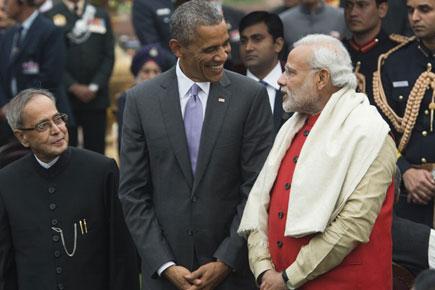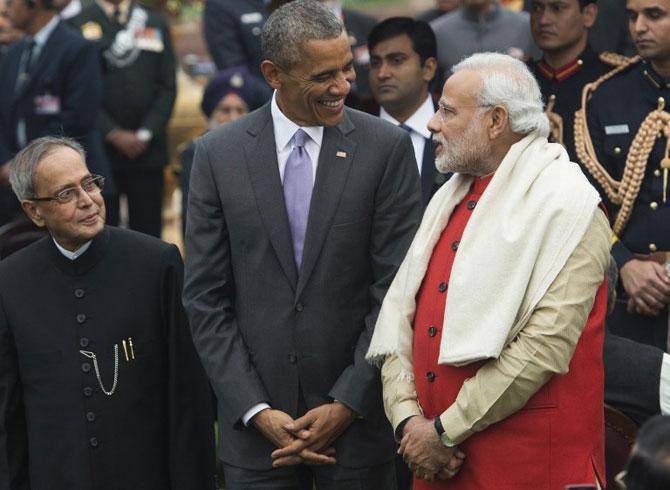India and the US saw the forging of a closer partnership, helped in great measure by the personal and visible bonding between Prime Minister Narendra Modi and President Barack Obama, as the two sides elevated their ties with a new 'Declaration of Friendship' and also managed to pull off a "breakthrough" agreement on their stalled civil nuclear deal

New Delhi: India and the US saw the forging of a closer partnership, helped in great measure by the personal and visible bonding between Prime Minister Narendra Modi and President Barack Obama, as the two sides elevated their ties with a new 'Declaration of Friendship' and also managed to pull off a "breakthrough" agreement on their stalled civil nuclear deal.

US President Barack Obama (C), Indian Prime Minister Narendra Modi (R) and Indian President Pranab Mukherjee (L). Pic/ AFP
ADVERTISEMENT
As Obama accompanied by wife Michelle Tuesday wound up three days of packed diplomatic and public engagements, his state visit where he was the chief guest at India's Republic Day parade has been termed as paving the way for a "new era" in India-US relations. US Deputy National Security Advisor Ben Rhodes said the signal being sent from Obama and Modi to their own respective governments "is going to catalyse a lot of activity".
"It also sends a message to the world, I think, that the US and India are going to be closer partners going forward," he said. "And that's entirely consistent with the president's focus on the Asia-Pacific region and building closer relations with emerging powers, particularly the world's largest democracy here in India."
Modi and Obama, who held over three-hour long talks Sunday, within hours of Obama touching down in New Delhi, announced the much-anticipated breakthrough agreement on implementation of their landmark civil nuclear deal, six years after it was signed.
That the two leaders had played a major part in getting the nuclear contact group to tide over their disagreements was indicated by Indian Foreign Secretary Sujatha Singh, who said the "political leadership played a key role" in pushing forward the agreement for setting up US-built civil nuclear reactors in India.
The US also signalled its support for an "early decision on India's entry" into the four multilateral export control regimes -- the Nuclear Suppliers Group, the Missile Technology Control Regime (MTCR), the Australia Group, and the Wassenaar Arrangement -- that would facilitate global business with India in the field of civil nuclear energy on which India, which has been largely dependent on energy-inefficient and climatically harmful fossil fuels, is hoping to pin its energy security in the coming years.
Noted strategic expert C. Uday Bhaskar termed the Obama visit "very successful". “I would characterise this as a very successful visit, and also a reflection of PM Modi’s ability to bring about a definitive change in the bilateral relationship in a very short time from September 2014 to now. On the nuclear issue, the way the roadblocks have been removed, it came about after Modi came into the chair and brought in the problem-solving mechanism into the relationship. The fact that he was able to infuse the political direction and energy has made all the difference," Bhaskar told IANS.
India and the US have also agreed to work closely in the Asia-Pacific region, bringing together India's 'Act East Policy' and the US's re-balance to Asia. "The US welcomes a greater role for India in the Asia-Pacific," Obama said at a town hall-like address before winding up his India visit Tuesday. Bhaskar, director of think tank Society for Policy Studies (SPS), said the Indo-US joint statement on working together in the Asia-Pacific and Indian Ocean "gives a better understanding of the political contours of the relationship".
Obama and Modi had "turned a corner for the United States and India" by resolving "issues in a long-stalled nuclear deal that for years kept US nuclear power companies from doing business in India", noted Alyssa Ayres, senior fellow for India, Pakistan, and South Asia at the Council on Foreign Relations.
"Obama, coming out of this symbolic and important visit to India, should demonstrate that Washington will do its part for India's future by integrating India into economic regimes focused on delivering growth," she wrote in a commentary in Fortune.
Influential Politico magazine noting that US and India were getting "serious about nuclear trade", wondered if it was a "'new era' for US-India relations". Along with energy cooperation also came defence cooperation in what is seen by analysts as a strategic shift in emphasis. The US, which has also watched the growing closeness between India and Russia in the co-production of weaponry and armaments, will now become a key co-producer of select defence equipment with India.
The two sides renewed the 10-year Defence Framework Agreement for enhanced defence engagement, and also inked the Defence Trade and Technology Initiative (DTTI), under which the two sides have agreed on co-production on four projects. These include the Raven unmanned aerial vehicle (UAV), and the "roll-on, roll-off" intelligence, surveillance and reconnaissance module for the Lockheed Martin-manufactured C-130 J transport aircraft.
The two leaders also gave a big push to the economic partnership, by meeting CEOs from both sides during two back-to-back meetings Monday. Obama announced $4 billion worth of new initiatives aimed at boosting trade and investment ties as well as jobs in India. The $4-billion deals include $2-billion financing for renewable energy investments in India through the US Trade and Development Agency and $1 billion in loans for small and medium businesses across India.
The camaraderie between Modi and Obama, built up over their past three meetings, including Modi's US visit in September, led to several photo-op moments of bear hugs, "Chai pe Charcha" talks over tea without aides, a walk in the elegant garden of Hyderabad House, chatting warmly like old friends during the Republic Day parade, and also their first name references of "Barack" and "Modi".
Christian Science Monitor saw "signs of a changing US-India relationship" amid pomp on Delhi's Rajpath, and noted "a trip to New Delhi designed to mend old differences had kicked off with a nuclear deal". On Monday, Obama accompanied by Michelle, was chief guest at India's 66th Republic Day parade, during which he was given a glimpse of India's military might, cultural diversity and technological prowess. After the two-hour open air affair, the US first couple later also attended President Pranab Mukherjee's traditional At Home reception at Rashtrapati Bhavan.
On Tuesday, in his final engagement, Obama addressed a town hall-like gathering at Siri Fort Auditorium, where he said that he firmly believes that America can be India's "best partner" and together the two countries can bring about more prosperity to their people and set examples for the world.
Modi and Obama also spoke on radio, in a joint 'Mann ki Baat' radio address, that was broadcast after he left. The joint radio address is a sequel to the joint article that the two had penned on India-US friendship in the Washington Post during Modi's US visit, with the audience this time being India's teeming millions who are still hooked on to radio for their news and entertainment.
 Subscribe today by clicking the link and stay updated with the latest news!" Click here!
Subscribe today by clicking the link and stay updated with the latest news!" Click here!







